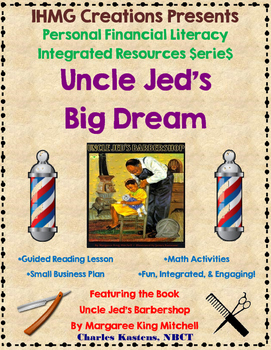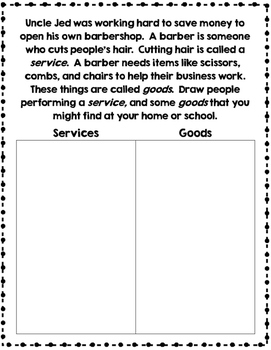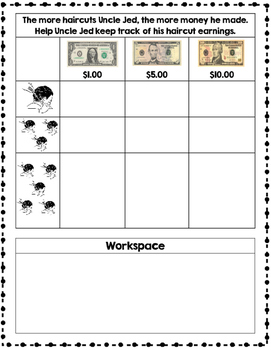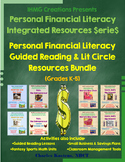"Uncle Jed's Barbershop"-No Prep Level A (ELA/Math/Personal Financial Literacy)
IHMG Creations
941 Followers
Grade Levels
1st - 3rd, Homeschool
Subjects
Resource Type
Standards
CCSS1.NBT.B.3
CCSS2.NBT.A.2
CCSS3.NBT.A.3
CCSS1.OA.B.4
CCSS2.OA.B.2
Formats Included
- PDF
Pages
24 pages
IHMG Creations
941 Followers
Also included in
- Are you struggling to find good, quality Personal Financial Literacy resources that can be integrated into your already busy day? If so, then look no further!This product offers 17 different resources that focus on teaching the Personal Financial Literacy (PFL) standards through language arts, mathPrice $70.00Original Price $103.55Save $33.55
- Are you struggling to find good, quality Personal Financial Literacy resources that can be integrated into your already busy day? If so, then look no further!This product offers nine different resources that focus on teaching economics (ECON) and Personal Financial Literacy (PFL) standards throughPrice $25.00Original Price $31.05Save $6.05
Description
Thank you for checking out this product! In this resource, students in grades 1-3 will meet ELA, math, and personal financial literacy standards through the use of a children's picture book. There are guided reading/literature circle and math components, as well as an opportunity for students to create their own six part small business plan!
In the book, "Uncle Jed's Barbershop," Margaree King Mitchell tells the true story of Sarah Jean and her favorite relative, Uncle Jed. Uncle Jed is a kind man with a big dream. He is the only African American barber in the county, and he wants to open his own barbershop. It is a heart-warming story of perseverance, dedication, and love!
I created this resource to creatively engage students in language arts, math, and personal financial literacy standards, using the book as the starting point.
This product could be utilized in a guided reading or literature circle setting, or as a whole group lesson during language arts resource. It could also be used to supplement your math block. However, the true value of this product is how it can be used to help teach personal financial literacy standards. Students also have the opportunity to create their own small business plan, which allows you to explore many different aspects of our economy!
Personal Financial Literacy (PFL) standards were created in 2007, with the mission of creating k-12 students who had a better understanding of how the economy works and how to manage their money. Currently, about half of the states have officially adopted the PFL standards. After doing some work with my district over the past three years to learn more about and help implement the standards, I believe that these are the most valuable set of standards we will teach our students! Whether a child grows up to be a doctor, a newspaper editor, or a stay-at-home-mom, they will all benefit from knowing how to create and use a budget.
There are many stand-alone PFL resources available through several different outlets. However, I have found that PFL works best when you can integrate them into what you are already doing within your literacy or math blocks. This is my first product to help accomplish this goal!
However you use it, I am sure both you and your students will enjoy the story of Uncle Jed, as well as the fun, engaging activities!
Thank you for looking!
In the book, "Uncle Jed's Barbershop," Margaree King Mitchell tells the true story of Sarah Jean and her favorite relative, Uncle Jed. Uncle Jed is a kind man with a big dream. He is the only African American barber in the county, and he wants to open his own barbershop. It is a heart-warming story of perseverance, dedication, and love!
I created this resource to creatively engage students in language arts, math, and personal financial literacy standards, using the book as the starting point.
This product could be utilized in a guided reading or literature circle setting, or as a whole group lesson during language arts resource. It could also be used to supplement your math block. However, the true value of this product is how it can be used to help teach personal financial literacy standards. Students also have the opportunity to create their own small business plan, which allows you to explore many different aspects of our economy!
Personal Financial Literacy (PFL) standards were created in 2007, with the mission of creating k-12 students who had a better understanding of how the economy works and how to manage their money. Currently, about half of the states have officially adopted the PFL standards. After doing some work with my district over the past three years to learn more about and help implement the standards, I believe that these are the most valuable set of standards we will teach our students! Whether a child grows up to be a doctor, a newspaper editor, or a stay-at-home-mom, they will all benefit from knowing how to create and use a budget.
There are many stand-alone PFL resources available through several different outlets. However, I have found that PFL works best when you can integrate them into what you are already doing within your literacy or math blocks. This is my first product to help accomplish this goal!
However you use it, I am sure both you and your students will enjoy the story of Uncle Jed, as well as the fun, engaging activities!
Thank you for looking!
Total Pages
24 pages
Answer Key
Included
Teaching Duration
N/A
Report this resource to TPT
Reported resources will be reviewed by our team. Report this resource to let us know if this resource violates TPT’s content guidelines.
Standards
to see state-specific standards (only available in the US).
CCSS1.NBT.B.3
Compare two two-digit numbers based on meanings of the tens and ones digits, recording the results of comparisons with the symbols >, =, and <.
CCSS2.NBT.A.2
Count within 1000; skip-count by 5s, 10s, and 100s.
CCSS3.NBT.A.3
Multiply one-digit whole numbers by multiples of 10 in the range 10–90 (e.g., 9 × 80, 5 × 60) using strategies based on place value and properties of operations.
CCSS1.OA.B.4
Understand subtraction as an unknown-addend problem. For example, subtract 10 – 8 by finding the number that makes 10 when added to 8.
CCSS2.OA.B.2
Fluently add and subtract within 20 using mental strategies. By end of Grade 2, know from memory all sums of two one-digit numbers.







